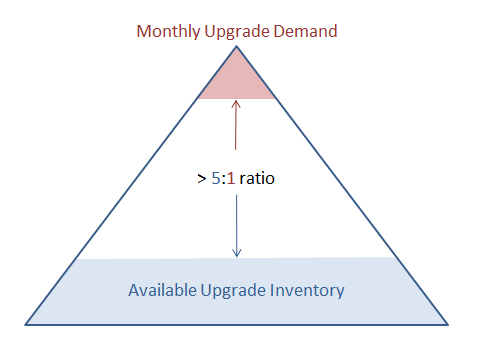Never Pay Full Upgrade Price
Buddy Upgrades – Finally, A ‘Good’ Pyramid Scheme!
The concept of a Buddy Upgrade is simple enough – when an employee needs a new phone but isn’t upgrade eligible, you use someone else’s service number that is upgrade eligible. If that borrowed line comes to a point of needing an upgrade, you borrow against someone else’s eligible upgrade and so on. The concept is similar to what most families practice with their family plans – you look for the next available upgrade to be applied against the family member most in need of an upgrade.
It is easy to manage Buddy Upgrades on family plans but with hundreds or thousands of business phones this can be more challenging. Like any pyramid scheme, this one relies on the principle that at any given time there are plenty of unused upgrade lines of service (bottom of the pyramid) to fill the demand for those users that can’t wait until their upgrade term matures before taking advantage of the latest technology (top of the pyramid). Of course Buddy Upgrades aren’t just for early adopters but may come into play when a device is lost, stolen or stops working and the user needs an immediate replacement.
Varying company philosophies – If expectations of every employee is that they will get a new upgrade on their one or two-year activation anniversary then the pyramid will look more like a cylinder and it will be very frustrating to execute a Buddy Upgrade process. However, if your company mobility policy encourages longer asset lifetimes and there is no expected employee entitlement to a timely upgrade then there may be a sufficiently large pool of available upgrades to mine for users in need of an upgrade before their line is eligible. A large inventory of data cards can help your ratios as they typically are not upgraded as frequently as tablets or smartphones.
Determining if you are a good fit – A simple mathematical calculation can tell you if you are a good fit or not for a Buddy Upgrade approach. At a minimum you will want your ratio of available upgrade inventory to be 5 times the projected monthly demand. While this may seem cautious you must remember that upgrade dates don’t necessarily become available on a smooth daily schedule and your upgrade demand will likely peak at times of newly introduced iPhones and smartphones. Determining the top of the pyramid, monthly upgrade demand, can be calculated from recent order history. The available inventory can be approximated by dividing your upgrade eligibility term (typically between 12 – 24 months) into your total current device count.
What you need to be successful – There are three essential components to a successful execution of Buddy Upgrades. First, you need the ability to accurately capture and maintain eligibility dates by service line for all active devices and frequently update them. Second, you need a centralized process to control and prioritize devices that will be accepted as upgrade candidates. This would require a step to approve or disapprove upgrade requests based on the user’s need and available inventory of upgradeable lines of service. Finally you need a controlled execution process that will match the line to be upgraded with the line donating its upgrade eligibility for that same carrier.
Implementation – If you are a good candidate based on culture and ratios indicated above you will find that a Mobility Managed Service (MMS) with online provisioning capability can allow the most efficient execution. Two particular challenges to be aware of are first, managing expectations and surprises when an employee that has gone well beyond their eligibility finds that their line has been used by someone else, and second, managing the cost assignment of the upgrade equipment to land on the proper line or cost center rather than the unsuspecting ‘buddy’ user. Some carriers handle this charge assignment issue more seamlessly than others.
Some recent studies indicate that 1 in 4 cell phones may be damaged yearly. The cost of replacement at full price can average over $500. Even a conservative 10% replacement rate and replacement upgrade delta cost of $250 translates into an expense of $50,000 a year on a population of 2,000 mobile devices. In this case, an effective Buddy Upgrade program would save over $4,000 a month.
